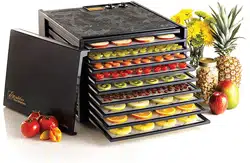Loading ...
Loading ...
Loading ...

14
JERKY
Many recipes are available, but it’s fun to make up your own concoction. You can use virtually
any combination of the following ingredients: soy, Worcestershire, tomato or barbecue sauce;
garlic, onion or curry powder, seasoned salt or pepper.
Pick a lean cut of raw meat as free from fat as possible; the higher the fat content, the shorter
the storage life of the jerky. The best way to get uniform pieces is with a meat slicer, but a
sharp knife will do. When using a knife, partially freezing raw meat will make slicing easier.
Slice the meat either with or across the grain. Jerky cut with the grain will be chewy; cut across
the grain will be very tender but more brittle. Cut into strips 1" wide, 3/18" thick and as long
as you want. Once sliced, cut off all visible fat.
To better preserve your jerky, apply either dry or brine cure prior to dehydrating. Dry cures are salt
and seasoning mixtures rubbed into the meat surfaces. Brine cures or marinades combine water
with the salt and seasoning. Meat is soaked in the brine until the salt is absorbed.
The Process
To dry cure, spread the meat strips in a single layer on a cutting board or some other flat
surface. Sprinkle the curing mixture on both sides of the strips. Coat the strips evenly. Layer
the strips one on top of another in a glass, plastic, or stoneware container that is sealed tightly.
Meat for brine curing should be layered with the cure poured over it to cover the top layers.
Place the container in the refrigerator and marinate for 6-12 hours (or preferably overnight.)
Turn the strips over several times to ensure thorough coating.
Dehydrating
Shake off any excess cure and spread the meat strips in a single layer on the dehydrator
trays. Dry at 165ºF/74ºC for approximately 4-6 hours, occasionally blotting off any fat droplets
that appear on the surface. While drying, the temperature will go up and down around the
set point - this is important to dry correctly. Your meat will hit 160º if you use the 165º - set
point on the dial.
Always test jerky using a cooled piece. Properly dried jerky, when bent, should crack but
not break.
Storage
Package cooled jerky in air-tight containers such as zip-top or vacuum sealed bags. For best
flavor retention, package the jerky into individual serving sizes and store in a cool, dark, dry
place. If beads of moisture form on the inside of the storage container, the jerky is not dry
enough and could mold - dry longer.
Loading ...
Loading ...
Loading ...
